Hydronic
heat pumps
ride the tide of electrification
Spacepak’s Jim Bashford notes the hydronic heat pump market is growing at a rapid pace thanks to the efficiency and adaptability of the equipment.
The interior portion of an air-to-water heat pump which provides space heating, cooling and domestic hot water to an upstate New York home, installed by The Radiant Store, located in Troy, New York.
Decarbonization goals drive growth in heat pump market.
BY NICOLE KRAWCKE
According to the United Nations, 2019 was the second warmest year on record at the end of the warmest decade (2010-2019) ever recorded. Additionally, carbon dioxide and other greenhouse gas levels were 18% higher from 2015 to 2019 than the previous five years, according to the World Meteorological Organization’s Global Climate 2015-2019 report. Evidence of climate change is affecting every country on every continent, disrupting economies as well as causing changing weather patterns, rising sea levels and more extreme weather events.
The growing concern for climate change — along with the declining cost and improved performance of renewable energy technology — has spurred many states to create clean energy programs and policies. According to the Clean Energy States Alliance (CESA), there are currently 17 states, along with the District of Columbia and Puerto Rico, that have adopted policies to move to either all-renewable or zero-emission electricity supplies.
Those in the industry know the HVAC system is the largest energy consumer inside a building, so it makes sense that the market is shifting toward heating and cooling using renewable-sourced electricity. This growing trend is already being seen in the hydronics market, where an increasing number of heat pumps are being used. John Siegenthaler, P.E., principal of Appropriate Designs in Holland Patent, New York, and longtime PM columnist, predicts heat pumps will eventually become “the new boilers” in both residential and commercial hydronic systems.
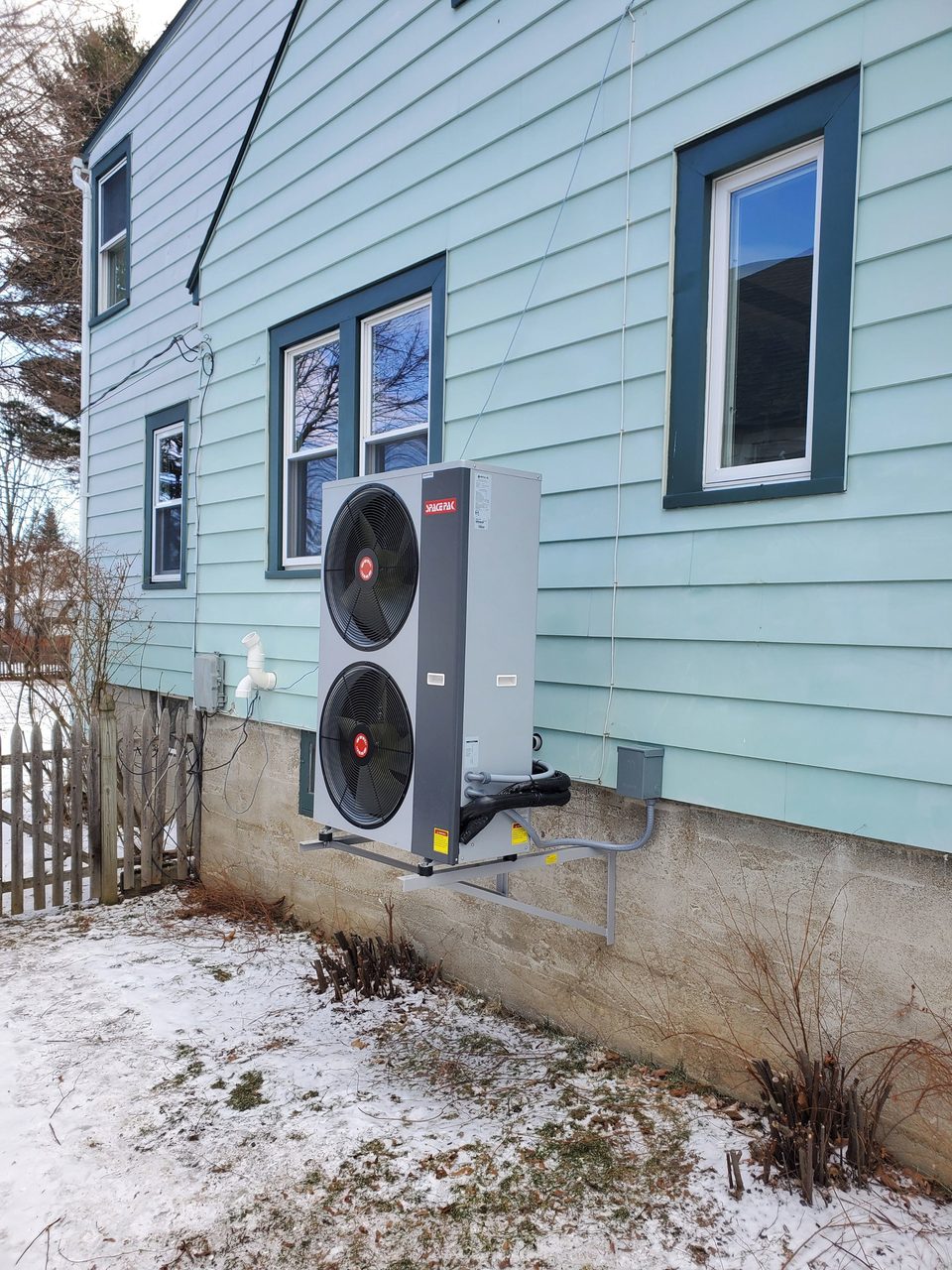
The outside view of a SpacePak residential hydronic heat pump installation.
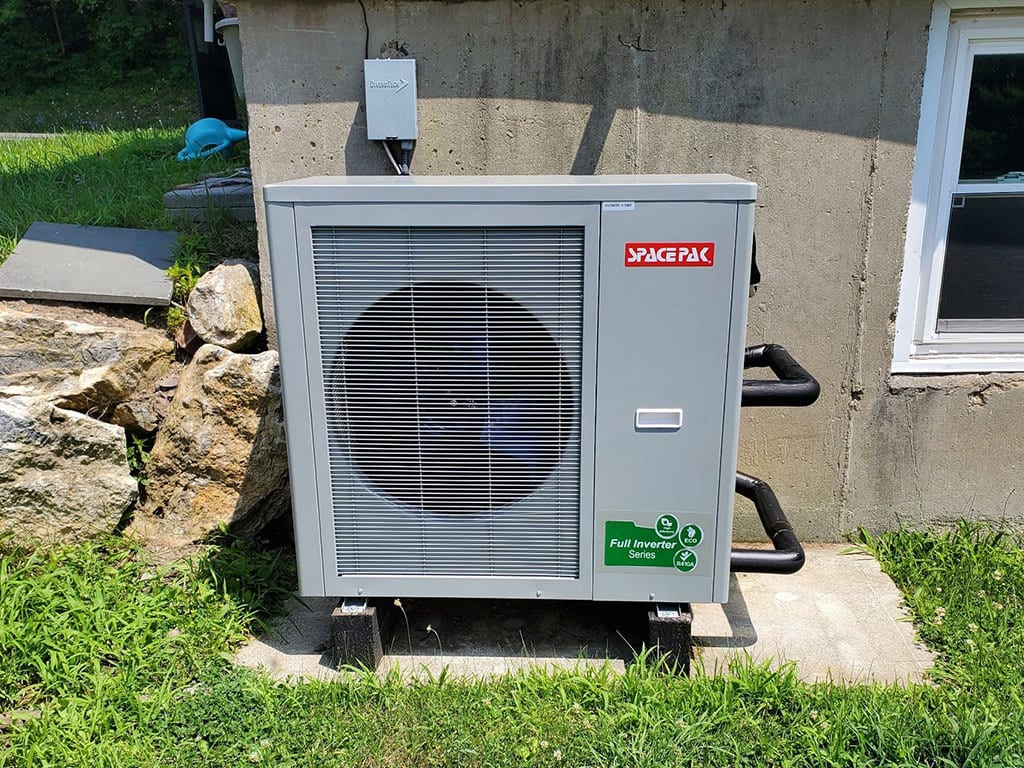
SpacePak notes its air-to-water heat pumps feature up to 70% less electricity usage than electric baseboard, and, when compared to a typical high-efficiency natural gas condensing boiler, its heat pumps can offer energy savings up to 47% with a seasonal COP of 1.7 to 3.0.
“Many state energy plans are being developed around decarbonization,” Siegenthaler says. “They are moving in the direction of reducing, and perhaps eventually, eliminating fossil fuels for use in heating buildings. At the same time, there are huge spending programs to encourage utility scale renewable generation of electricity (large solar farms and wind turbine farms). The most common way to use electricity for heating and cooling buildings is through use of heat pumps — of all types. Both air-to-water and geothermal water-to-water heat pumps will be increasingly used as sources for hydronic distribution systems. Gas-fired boilers are not going away next year, but that market is likely to look very different 10-15 years from now.”
Siegethaler’s home state of New York is aiming at 100% renewable electricity by 2030, and there are some early indications that codes will be influenced to eventually phase out fossil fuels in both new and end of equipment life situations, he notes.
“The hydronic heat pump market is growing at a rapid pace, thanks in large part to the efficiency of the equipment and the ability, in many cases, for the new equipment to adapt to the home’s existing hydronic system,” says Jim Bashford, national sales and training manager for SpacePak, a division of Mestek. “There is also the added advantage of air-to-water heat pumps to offer a level of cooling to the home when properly designed. The growth of the market is not only driven by the consumers’ interest in energy efficiency, but also HVAC contractors understanding of the air-to-water technology and its versatility. This allows the contractor to work with the end user to create the most flexible and efficient system available for every situation.”
“Combining a hydronic system with a geothermal heat pump allows for some additional options to really maximize the energy savings impact.” – IAN MCIVER
Ian McIver, product manager for Bosch Thermotechnology, agrees, saying, “People are turning away from the fossil fuels of traditional boiler systems and moving more toward heat pump systems simply because they are so much more efficient.
“Particularly on the water-source side, it’s the best efficiency we have in the market,” McIver adds. “Combining a hydronic system with a geothermal heat pump allows for additional options to really maximize the energy savings impact. You get heating, cooling and indirect hot water. In a lot of applications with a pool, you can also incorporate pool heating. There are some pretty innovative systems that can tie in together to really maximize the energy efficiency gains.”
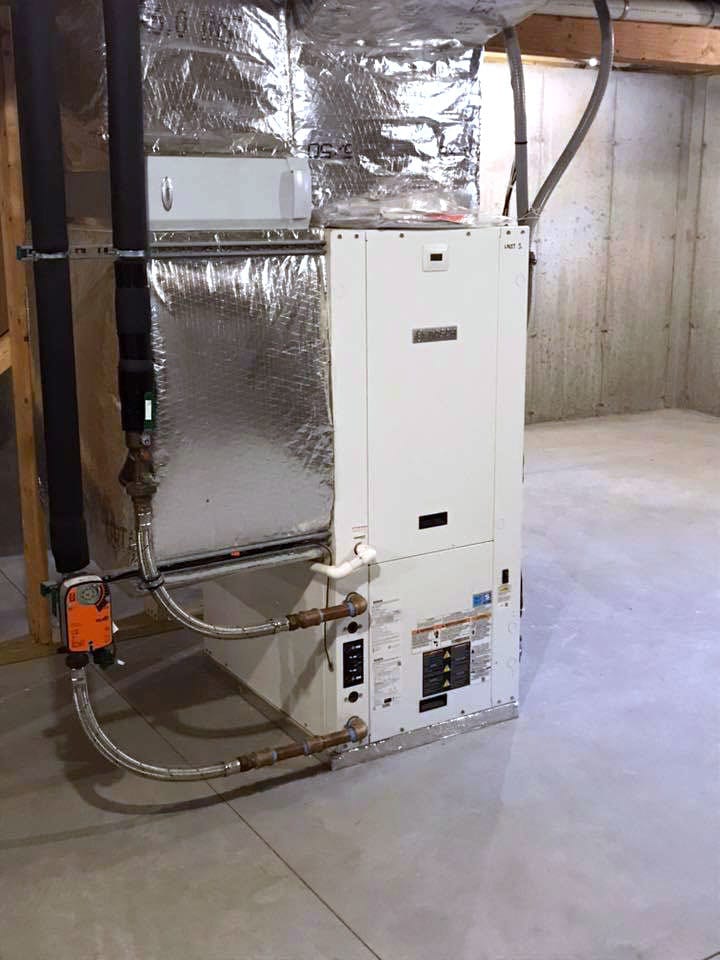
Bosch Thermotechnology’s Ian McIver notes more and more people are turning away from traditional boiler systems in favor of heat pump systems’ superior efficiency.
There are a number of different factors affecting the hydronic heat pump industry, some of it political, and some of it is just market dynamics driven by the energy efficiency and environmental benefits of the products, notes Mark Chaffee, vice president of government relations and product management for Taco Comfort Solutions.
“When you combine innovative products with the bigger green energy trends and utility incentives, it actually starts to move and transform the market,” he says. “The market is certainly in its infancy, but there is great potential here. Many states, municipalities and territories are moving their environmental planning away from fossil fuels. A number of cities and towns have determined they will not issue any permits for gas lines coming into a house or for oil-fired equipment. So now, we have to electrify. We see it similar to the overall trend of electric vehicles. We are trying to move away in all facets from fossil fuel usage to meet those energy goals states have set.”
Chaffee notes a state-of-the-art, high-efficiency HVAC system might have a 95% efficiency, but when you get into heat pumps, the coefficient of performance (COP) is about 2 to 4, meaning you have 200% to 400% efficiency.
“Heat pump technology, in general, is incredibly efficient,” he explains. “That’s why we’ve seen worldwide growth in all things heat pump, from heat pump water heaters to mini splits to commercial VRF systems, the whole realm. But most of these systems are refrigerant and air-based. The opportunity we see is to use water as the distribution medium, as it has a global warming potential of zero. And water, when compared to air or refrigerant, has 16 times more carrying capacity. Think about when you warm up your oven to 150° F to keep a plate of pancakes warm — you can stick your hand inside and wave it around. You are going to notice it is warm, but that’s it. When you stick your hand in 150° water and swish it around, you’re going to the hospital after about a few seconds. Water is a much better, far more efficient and environmentally-friendly way to transfer Btu when heating and cooling.”
Jason Abajian, North America water sales manager for Resideo, points to shipment data from the Air Conditioning, Heating, and Refrigeration Institute (AHRI) as evidence for growth in this segment.
“Currently there is a significant growth of the use of heat pumps in the U.S.,” he says. “According to the May 2021 AHRI shipment report, heat pump shipments were up 49% compared to May 2020, and up 27% to the average shipment rate from 2018 to 2020. This trend is due to improvements in the technology and the ability to provide both heating and cooling systems from a single piece of equipment.”
Abajian notes there are several factors driving this growth, including the perception of the efficiency of using electricity to heat and cool homes.
“Multifamily complexes and businesses have become a driving force in the use of heat pumps,” he adds. “The ability to utilize a single piece of equipment that is capable of being installed in a small footprint makes it an attractive option.”
“Heat pumps are a significant portion of the answer to meet low emissions goals. I think they will be used in combination with fossil fuel systems for several years, and continue to grab an increasing percentage of the new system market.” – JOHN SIEGENTHALER
Meeting low emissions goals
Well-funded incentive programs are also encouraging the use of heat pumps as well as solar photovoltaic systems.
“Heat pumps are a significant portion of the answer to meet low emissions goals,” Siegenthaler says. “I think they will be used in combination with fossil fuel systems for several years, and continue to grab an increasing percentage of the new system market. Hydronic professionals need to learn how to sell the combination of both air-to-water and water-to-water heat pumps against ductless mini-split systems, as well as against VRF systems in commercial markets.”
According to Siegenthaler, hydronic pros need to stress the advantages of such systems, including the superior comfort through radiant and convective heat output; the ability to provide space heating, cooling and domestic hot water from the same system; the highly flexible design to accommodate existing conditions; non-proprietary systems serviceable by many competent technicians; less volatility to constantly changing refrigerant regulations; far less refrigerant (if any) within buildings; the ability to integrate thermal storage and coordinate with time-of-use electrical rates; and better interior aesthetics, meaning no “little white boxes” on the walls, as is the case with ductless mini-split systems.
State and government plans help bring light to the need for renewable energy dependency, Bashford notes.
“With that push, it encourages contractors, sales professionals and homeowners to research these systems on their own time and choose what would best suit their personal expectations,” he says. “Hydronic air-to-water heat pumps are a great answer in pushing toward clean energy and low emission goals. With their individual technologies, the systems are designed to run on electricity; however, with inverter and load-matching abilities, they can truly create only the energy needed to heat or cool the home without any waste.”
Any kind of government program or incentives tend to drive up the interest for newer technologies to be utilized, Abajian notes.
“As manufacturers see the demand for these types of equipment, they tend to spend more resources developing them,” he explains. “The affordable inverter technology allows for highly efficient, externally grid-controlled units, which make it possible for the utilities to manage power consumption and utilize off-peak control with demand response. If the generation of the power comes from renewables — such as photovoltaic solar, wind, hydroelectric and nuclear sources — these types of units are one of the best solutions to help meet low emissions goals.”
“With many areas offering rebate programs for air-to-water equipment and the ability for the systems to integrate with existing equipment, the ‘cost to value’ is brought down to a much more reasonable level.” – Jim Bashford
Impediments
While hydronic heat pump systems offer many advantages, including unparalleled energy efficiency, they have yet to become mainstream in the U.S. market.
“The current generation heat pumps can only produce water temperatures in the 125° to 130° range,” Siegenthaler says. “As such, they are not a ‘drop in’ replacement for a fossil fuel boiler in a system that might require water temperatures of 180°, or more. However, in these higher temperature systems, heat pumps can still provide the majority of the seasonal heating energy and be supplemented by either an existing boiler or a new boiler. In new construction, they can provide 100% of the heating and cooling energy. They could also be supplemented by an electric boiler in cases where an all-electric system is desired.”
Siegenthaler also points to the elephant in the room — the electrical grid — as a serious barrier to entry.
“The North American electrical grid needs to be upgraded soon to handle the potential loads associated with mass adoption of heat pumps over fossil-fuel systems,” he explains.
Abajiann agrees, noting that current grid considerations have to be made when making these types of transitions, along with climate applications and limitations to operate in climates with temperature extremes.
“There are also environmental concerns about the refrigerants used in these units to accomplish the refrigeration cycle, which makes these units operate at the efficiencies they do to produce the COP, but also give the advantage from an energy consumption aspect,” Abajian explains.
Bashford also points out that the initial cost for heat pump systems is still rather high.
“However, with many areas offering rebate programs for air-to-water equipment and the ability for the systems to integrate with existing equipment, the ‘cost to value’ is brought down to a much more reasonable level,” he says.
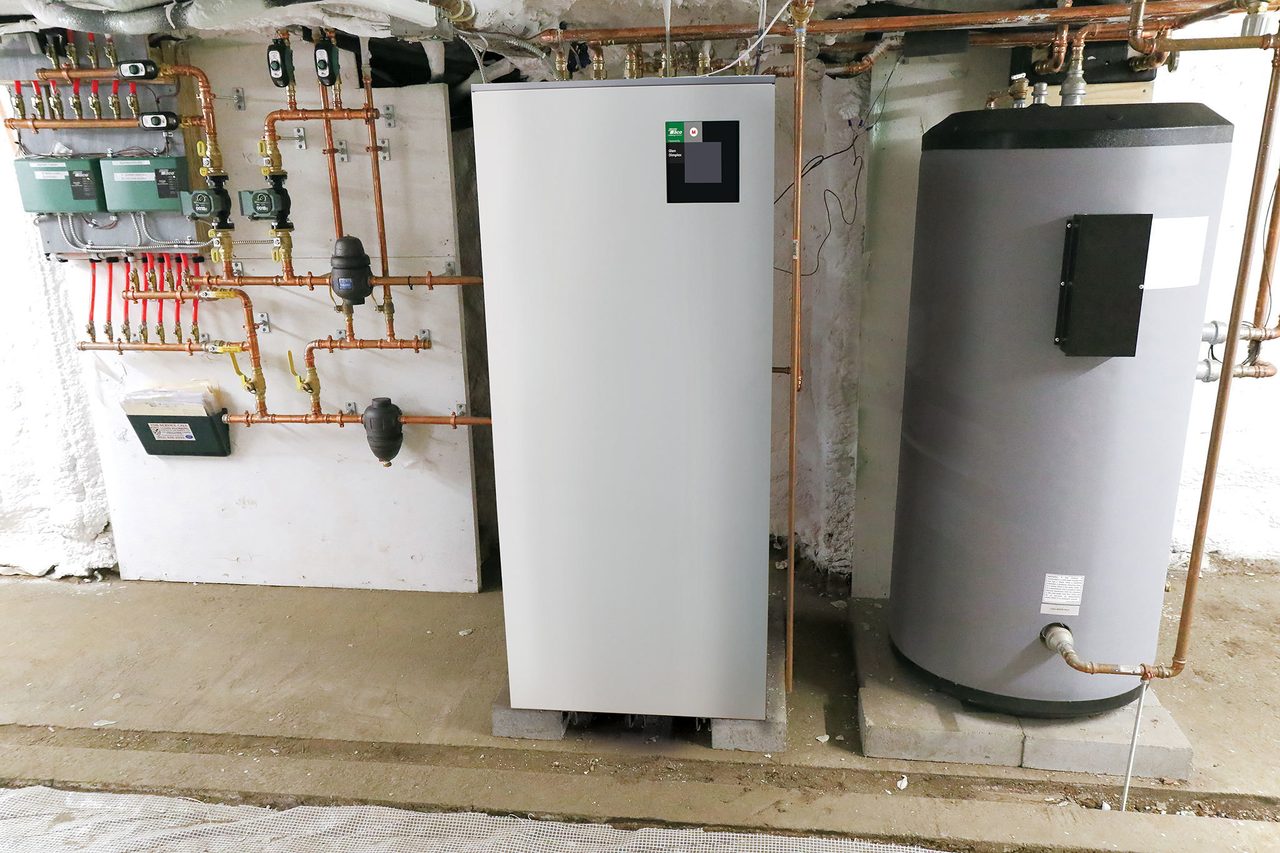
A complete hydronic-based heating, cooling and domestic hot water system installed in a historic net-zero Airbnb in Vermont. The unit features the System M indoor unit (including pumps, piping, buffer tank and controls housed within a turn-key enclosure) and an indirect DHW tank (on the far right) connected to a radiant heating and hydronic fain coil cooling system.
Opportunity for PHVAC contractors
The hydronic heat pump market has nowhere to go but up, and plumbing and HVAC contractors would do well to capitalize on this growing trend.
“These systems are incredibly flexible and adaptable,” Bashford notes. “When using hydronics over VRV/VRF-type systems, you are not hampered by normal refrigerant limitations. With systems being designed for — and able to offer — low ambient heating, cooling and domestic hot water offset, they really are systems that can handle just about any situation.”
Chaffee agrees, saying hydronic heat pump systems can be a complete opportunity for contractors to offer an all-electric comfort system to their customers.
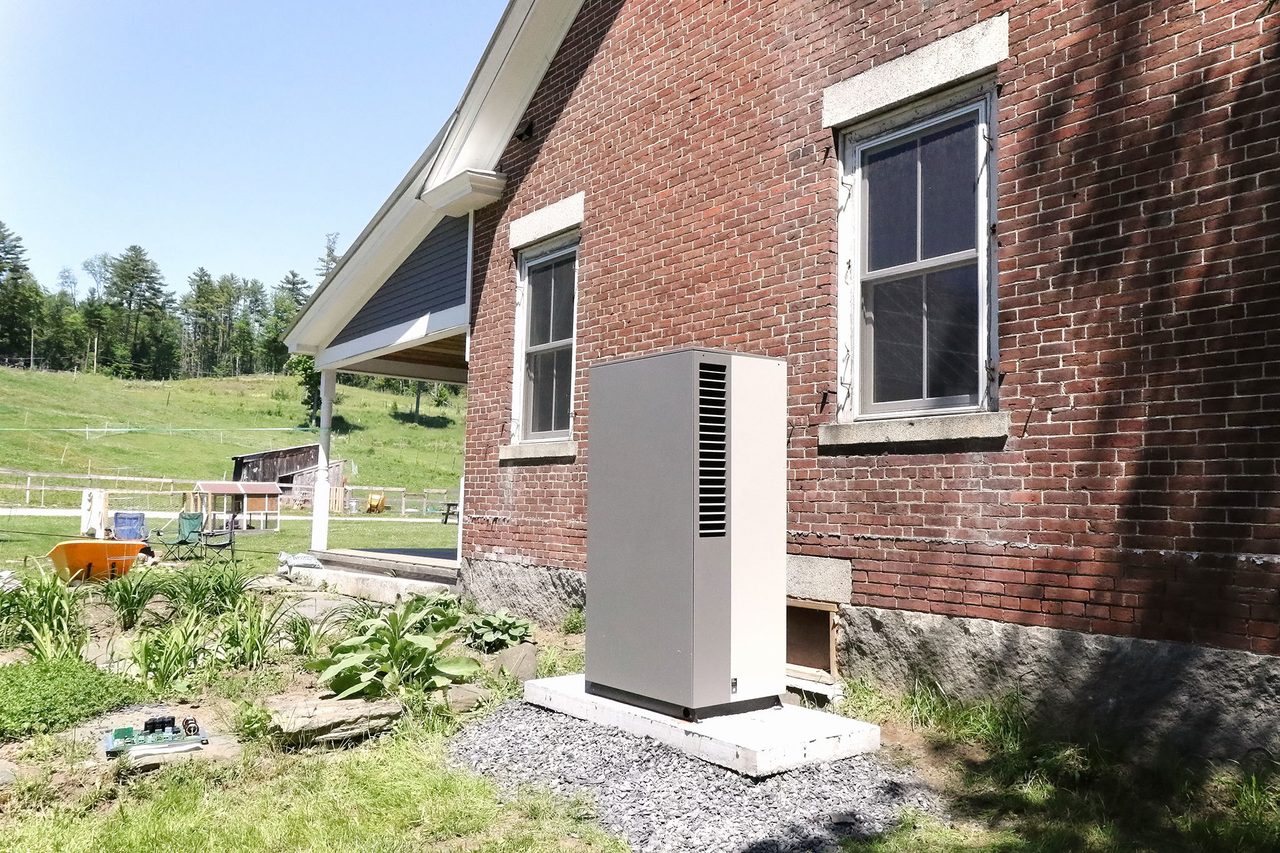
Taco Comfort Solutions’ System M outdoor unit installed at a historic net-zero Airbnb in Vermont.
“The efficiency, comfort and flexibility are all great for contractors. And then you get some other benefits, at least with a Taco unit, in terms of control, diagnostics and easy installation. If something goes wrong, the system emails the installer, sometimes before the homeowner even knows there is an issue.” – Mark Chaffee
“The efficiency, comfort and flexibility are all great for contractors,” he says. “And then you get some other benefits, at least with a Taco unit, in terms of control, diagnostics and easy installation. If something goes wrong, the system emails the installer, sometimes before the homeowner even knows there is an issue. We’ve baked a lot of technology on top of this incredibly efficient system. And it’s definitely the most comfortable, quiet, turn-key system there is.”
And because hydronic heat pumps can handle heating, cooling and domestic hot water, it makes contractors’ lives easier, Chaffee adds.
While contractors should definitely be offering hydronic heat pump systems to their clients, Siegenthaler encourages all hydronic pros to remain neutral regarding the politics of decarbonization.
“The forces that have and will continue to shape the energy markets are beyond the control of any individual or company,” he says. “Instead, they should get ready to seize a major opportunity to expand their system offerings to increasingly receptive consumers, leveraging modern heat pumps in combination with their existing skills for designing and installing hydronic systems.”
“Embracing this technology in conjunction with hydronics will be critical to moving the industry forward. If we don’t promote the development of these systems, hydronics could be displaced by mini-splits as a comparable alternative.” – Jason Abajian
The future of hydronic heat pumps
As fossil fuels continue to increase, the energy cost-savings hydronic heat pump systems provide will become more and more attractive to homeowners and commercial building owners alike.
“The price of energy is subject to the political roller coaster that we’ve be riding over the last few years,” Siegenthaler says. “I suspect significant increases in fossil fuel costs if current federal and state decarbonization policies remain in effect. This will further encourage heat pumps as preferred heat sources.”
Siegenthaler also notes the geothermal market will continue to hold market share and possible even increase a bit, provided the current subsidies remain in place. If the subsidies are eliminated, the high cost of a geothermal heat pump system will reduce the market share significantly.
McIver agrees, saying the market is very tied to the federal tax credits.
“Unfortunately, it’s still an expensive technology to install,” he explains. “Particularly geothermal where you’ need to dig wells. There’s a large upfront cost. It does pay for itself in the long run, but it requires somebody to pay for that bill up front. Currently, the federal tax credit is 26% for 2021 and 2022, but will drop to 22% in 2023, and as of now, is non-existent in the legislation for 2024. Any time a tax credit stops, it tends to affect the market pretty significantly. If it were to stop in 2024, that’s one direction for the market. But, if it gets renewed by the new administration, then it will continue to grow steadily — especially as more people become aware of the climate situation and how important electrification is on our impact on greenhouse gases. This factor can really shape peoples’ perception and desire for this heating and cooling solution in their homes.”
Air-to-water heat pumps are poised to gain a significant share of the market where heat pumps are used with new or upgraded hydronic systems, Siegenthaler explains.
A properly configured hydronic system will provide space heating, cooling and domestic hot water. The use of modern heat pumps to provide superior comfort using low-temperature hydronic radiant panel distribution systems is a win/win combination.
“They install for far less than equivalent geothermal heat pump systems, and offer good ROI,” he says. “It’s important to not judge the performance of any heat pump system based on COP. It’s the overall life-cycle cost of the installation that matters.
“Both air-to-water and geothermal water-to-water heat pumps can produce chilled water for cooling,” he continues. “This, in my opinion, is a major ‘game-changer’ for the North American hydronics market. A properly configured hydronic system will provide space heating, cooling and domestic hot water. The use of modern heat pumps to provide superior comfort using low temperature hydronic radiant panel distribution systems is a win/win combination.”
Chaffee also believes the hydronic heat pump market is staged for large growth.
“We’re betting on it,” he says. “There are more players in the market, and people are doing a better job with it. I’ve been in this industry for longer than I’d like to admit, and this reminds me of the very early days of radiant heating, it really does. Back then, we all needed to learn a lot, including how to pipe, how much to pipe, how to size the pumps, what temperatures to set the system at and everything about the controls. It took a while; and there was a lot of hand holding, but the opportunity to provide a better comfort experience was huge. We’re in that early phase now with air-to-water heat pumps. We’re hoping to take what we’ve learned in introducing other technologies and make this transition easier. There’s also a lot of work being done around utility incentives. That combination is going to help transform the marketplace.”
Bashford predicts the market will continue to grow, with an emphasis on clean energy efficiency and flexibility.
“Air-to-water technology will become the go-to for all heating, cooling and domestic hot water needs,” he notes.
When it comes right down to it, the future of this market is really up to the industry pros, according to Abajian.
“Embracing this technology in conjunction with hydronics will be critical to moving the industry forward,” he explains. “If we don’t promote the development of these systems, hydronics could be displaced by mini-splits as a comparable alternative. This would result in a loss of the benefits gained by the use of fluids to provide a radiant system which provides a level of comfort and efficiency that is far superior to moving and conditioning air in a living space.”

Photos courtesy of John Siegenthaler, SpacePak, Bosch Heating & Cooling and Taco Comfort Solutions.
Nicole Krawcke is chief editor of Plumbing & Mechanical.
